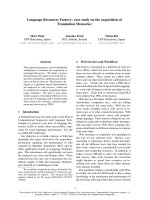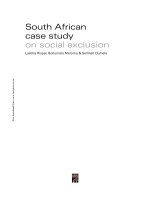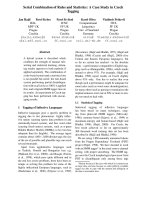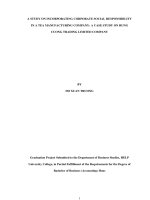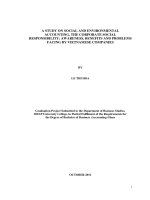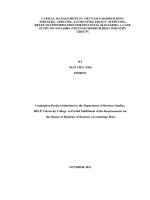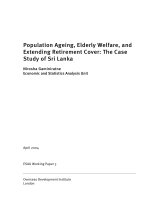South African case study on social exclusion potx
Bạn đang xem bản rút gọn của tài liệu. Xem và tải ngay bản đầy đủ của tài liệu tại đây (1.74 MB, 55 trang )
Laetitia Rispel, Boitumelo Molomo & Sellinah Dumela
South African
case study
on social exclusion
Free download from www.hsrcpress.ac.za
This work was made possible through funding provided by the World Health
Organization (WHO) via Lancaster University. It was undertaken as work for the SEKN
established as part of the WHO Commission on the Social Determinants of Health
(CSDH). The views presented in this report are those of the authors and do not
necessarily represent the decisions, policy or views of WHO or CSDH Commissioners.
Published by HSRC Press
Private Bag X9182, Cape Town, 8000, South Africa
www.hsrcpress.ac.za
First published 2008
ISBN 978-0-7969-2231-1
© 2008 Human Sciences Research Council
Print management by GREYMATTER & FINCH
Printed by RSA Litho
Distributed in Africa by Blue Weaver
Tel: +27 (0) 21 701 4477; Fax: +27 (0) 21 701 7302
www.oneworldbooks.com
Distributed in Europe and the United Kingdom by Eurospan Distribution Services (EDS)
Tel: +44 (0) 20 7240 0856; Fax: +44 (0) 20 7379 0609
www.eurospanbookstore.com
Distributed in North America by Independent Publishers Group (IPG)
Call toll-free: (800) 888 4741; Fax: +1 (312) 337 5985
www.ipgbook.com
Free download from www.hsrcpress.ac.za
List of tables, figures and boxes iv
Acknowledgements v
Acronyms and abbreviations vi
Executive summary vii
Chapter 1 The global and national context 1
Global response to health inequities 1
South African case study 2
Country profile 2
The current context 6
Chapter 2 Aims and methodology 15
Aims and focus 15
Methodology 16
Chapter 3 Social exclusion:
constructs and policies 19
Constructs of social exclusion 19
Affected groups 22
The impact of social exclusion 23
Social inclusion policies 25
Chapter 4 Appraising South African policies 29
Free healthcare 29
Cash transfers and support grants 31
Bana Pele 33
Summary 38
Chapter 5 Key issues and recommendations 41
Key issues 41
Recommendations 41
References 43
CONTENTS
Free download from www.hsrcpress.ac.za
iv
Tables
Table 1.1: Health inequalities in South Africa by race (1994) 5
Table 1.2: Selected indicators for South Africa from HDR (2006) 9
Table 1.3: Selected maternal and child health indicators for South Africa (1998) 12
Table 1.4: The ten leading underlying causes of death (2004) 12
Table 1.5: Rank comparison of the five leading causes of death by race (2004) 13
Table 2.1: Key informant interview topics 16
Table 3.1: Health inequities in South Africa (1998) 22
Table 3.2: Categories of policies addressing social exclusion or its proxies 26
Table 4.1: Types of CSGs and eligibility criteria 32
Table 4.2: Bana Pele principles 35
Table 4.3: Summary of policies appraised 38
Table 4.4: Enabling factors for policy implementation 38
Figures
Figure 1.1: South Africa and its provinces 3
Figure 1.2: South Africa’s population pyramid – percentage of the total South African
population in each five-year age group by sex (October 2001) 3
Figure 1.3: Official unemployment rate among those aged 15–65 years by province
(October 1996 and October 2001) 8
Figure 1.4: Burden of disease by province (2005) 10
Figure 1.5: The HIV epidemic among South African antenatal clinic attendees
(1990–2002) 10
Figure 1.6: HIV prevalence by age and sex, HSRC household survey of HIV (2005) 11
Figure 4.1: Bana Pele identification and referral form 36
Boxes
Box 1.1: The legacy of apartheid health services 4
Box 1.2: Summary of the National Household Survey of Health Inequalities
in South Africa (1995) 5
Box 1.3: Trends for social determinants of health (1996–2001) 7
Box 3.1: Constructs of social exlusion 19
LIST OF TABLES, FIGURES AND BOXES
Free download from www.hsrcpress.ac.za
v
This case study was funded by the World Health Organization (WHO) via Lancaster
University
. Nico Jacobs is thanked for his excellent administrative and logistical support.
We wish to acknowledge the support of Professor Jennie Popay, the overall Social
Exclusion Knowledge Network (SEKN) coordinator.
We also want to thank Karl Peltzer for his input and comments on drafts of the report.
We have greatly benefited from the input and contributions of the 22 key informants,
and other network members. Marijke van Vuuren is thanked for editorial assistance.
We are grateful to the South African Human Sciences Research Council (HSRC) for giving
home to the sub-regional hub.
Lastly, we thank Mary Ralphs and her production team at the HSRC Press.
ACKNOWLEDGEMENTS
Free download from www.hsrcpress.ac.za
vi
AIDS Acquired Immune Deficiency Syndrome
ANC African National Congress
CASE
Community Agency for Social Enquiry
CBO community-based organisation
CCT conditional cash transfer
CSDH Commission on Social Determinants of Health
CSG child support grant
DoH Department of Health
DSD Department of Social Development
GDP gross domestic product
GPG Gauteng Provincial Government (South Africa)
HDI Human Development Index
HDR Human Development Report
HIV Human Immuno-deficiency Virus
HSRC Human Sciences Research Council (South Africa)
IMR infant mortality rate
IRIF Inter-Regional Inequality Facility
KN knowledge network
MDG Millennium Development Goal
PIMD provincial indices of multiple deprivation
PMTCT prevention of mother-to-child transmission of HIV
RDP Reconstruction and Development Programme
RSA Republic of South Africa
SASSA South African Social Security Agency
SD social determinants
SDH social determinants of health
SEKN Social Exclusion Knowledge Network
SSA sub-Saharan Africa
StatsSA Statistics South Africa
TB Tuberculosis
UNDP United Nations Development Programme
WHO World Health Organization
ACRONYMS AND ABBREVIATIONS
Free download from www.hsrcpress.ac.za
vii
The World Health Organization (WHO) has established a Commission on Social
Determinants of Health (CSDH) to suppor
t countries and global health partners in
addressing the social factors leading to ill health and health inequities. The most important
objective of the Commission is to leverage policy change by turning existing social
determinants of health (SDH) public health knowledge into actionable global and national
agendas. The Social Exclusion Knowledge Network (SEKN) was established as part of the
work of the Commission. The scope of the SEKN is to focus on and examine the relational
processes excluding groups of people in particular contexts from engaging fully in
community and social life.
South African case study
The aims of the South African case study were to:
Explore the various constructs of social exclusion and its impact on health and •
well-being;
Examine the relational processes that serve to exclude groups of people in particular •
contexts from engaging fully in community and social life, at both macro and micro
levels;
Identify and appraise examples of policies, programmes, actions and institutional •
arrangements that have the potential to address exclusionary processes and ultimately
reduce the impact of health inequalities; and
Explore factors that enable and/or constrain the implementation and scaling up of •
policies and actions to address social exclusion.
This South African case study is based primarily on a review of published literature and
key informant interviews. The document is not intended to provide a comprehensive
overview or scientific analysis of social exclusion experiences or activities. Rather, its aim
is to draw on available knowledge and experience, to highlight lessons learned, and to
contribute to the development of key recommendations of the SEKN.
Chapter 1 gives a high-level overview of the Republic of South Africa (RSA), describes
key aspects of the current policy landscape relevant to promoting health equity, and
summarises available baseline indicators of the scale of inequality. In 2006 the RSA, had
an estimated mid-year population of 47.4 million, of which 51 per cent were female. Life
expectancy at birth was estimated at approximately 49 years for males and 53 years for
females. The 2006 Human Development Report (UNDP 2006) ranks the RSA at 121 out of
177 countries. The overall Human Development Index (HDI) decreased from 0.691 in 2000
to 0.653 in 2004, mainly due to the HIV and AIDS epidemic. South Africa has a quadruple
burden of diseases, consisting of HIV and AIDS, poverty-related diseases, chronic lifestyle
diseases, and high injury rates. The country’s legacy of apartheid is also reflected in
racially-based health status inequalities, many of which persist more than a decade after
democracy. The black African majority continue to bear the greatest burden of ill-health in
the country. Health inequities are also influenced by levels of wealth, geography, and the
educational level achieved by mothers. Access to health services is lowest for those in the
poorest 20 per cent of the population, with 51 per cent immunisation coverage of children
in the poorest 20 per cent, compared with 70 per cent for those in the richest 20 per cent.
Similarly, infants and children under five in the poorest 20 per cent are more likely to die,
compared with those in the richest 20 per cent.
Chapter 2 summarises the conceptual approach to and methods used in the case study,
including limitations. In addition to the literature review, 22 key informants in South Africa
EXECUTIVE SUMMARY
Free download from www.hsrcpress.ac.za
South African case study on social exclusion
viii
were interviewed, representing senior officials in national ministries, academics and
members of civil society.
A semi-structured interview schedule consisting of 30 questions
was used to collect information from key informants. The project was constrained by time
limitations and numerous competing priorities.
Although a small group was interviewed and no generalisations can be made, the views
expressed present rich perspectives on and insights into the various aspects of social
exclusion and inclusion, and the pathways to health inequalities.
Chapter 3 describes the key issues and themes arising from the South African case study,
comments on informants’ perceptions of affected groups, and the impact of social exclusion
on health and well-being, and concludes with the identification of policies and programmes
with the potential to reduce social exclusion and reduce health inequalities. The social
exclusion discourse has been more extensive in the north and alternative discourses of
poverty, marginalisation and vulnerability have received much more attention in South
Africa. The key informants’ constructs of social exclusion include four main categories,
although these tend to overlap in practice. The contextual construct includes proxy terms
and/or alternative discourses of poverty, marginalisation and disadvantage. The relational
perspective includes political and social systems and processes, and emphasises the multi-
dimensional nature of social exclusion. Extreme marginalisation focuses on categories
of excluded people. The paradox of exclusion/inclusion incorporates the notion of the
adverse incorporation of certain groups of people. The pathways between social exclusion
and health are complex, but four main mechanisms are useful in explaining some of
the complexity. The pathways are social stratification, differential exposure, differential
susceptibility and differential consequences.
Chapter 4 presents an appraisal of three of the policies or actions identified as part
of the South Africa case study: free healthcare policy; social transfers, with a particular
emphasis on the child support grant, and the Bana Pele (‘children first’) Programme,
a Gauteng provincial programme for integrated child care. The free healthcare policy
has been effective in removing barriers to access. Positive effects include an increased
utilisation of primary healthcare services, and an increased use of preventive services
such as antenatal care and family planning. The policy has not had an impact on health
status, but that was not its primary intention. However, there have been unintended
consequences, the most important of which has been negative health-worker attitudes
because of inadequate communication and their lack of involvement in policy design
and discussions on implementation.
With regard to the child support grant, the number of beneficiaries has been rising rapidly,
reaching in excess of six million children in South Africa. Studies have shown that social
grants are the most pro-poor item of government expenditure and provide households
with income, and support second-order effects that further reduce poverty. These include
sending young children to school, providing better nutrition for children, and looking
for work more intensively. The grants have been plagued by implementation difficulties
including fraud, delays in approving grant applications, and difficulties in accessing
payment, with great inequities across provinces. Relatively little is known about the
link between government social grants and the private social safety net, or about the
differential impacts of social grants, by gender and by geographical areas, or their effects
on health or labour migration. It has been argued that the use of a means test and
different interpretations of means testing may act as a significant barrier to the greater
Free download from www.hsrcpress.ac.za
ix
take-up of social grants among poor households, particularly in rural areas, where the
poor hav
e the least access to the official identification documents necessary to access
social grants.
A rapid appraisal of the provincial Bana Pele Programme shows that many of the services
are not new in the current South Africa social assistance system. The Bana Pele Programme
is implemented through an integrated approach, by identifying, referring and tracking
beneficiaries, and through the establishment of a common database of children in need
within the province. While Bana Pele shows promise and appears to be a worthwhile
endeavour, a formal impact assessment of the programme has not been done. Many of the
current indicators are output-focused (number of beneficiaries) rather than impact-focused
(reduction in vulnerability).
Factors enabling policy implementation include research evidence; political support;
community or civil society support, advocacy and lobbying; public consultation and
debate about policy and programmes; as well as the ability to enforce policy through
legislation, a functioning accountability system, economic growth and cultural support.
The main barriers identified to policy implementation were wide-ranging, and include
political and fiscal constraints, a lack of skills and human resources, the attitudes of public
servants, vested interests of the private sector, misuse or default by consumers, and
inadequate policy communication strategies.
The conclusion highlights that many of the policies in post-apartheid South Africa have
been directed at correcting historical injustices and redressing the wrongs of the past.
However, after more than a decade of democracy, many of the historical and intractable
inequalities remain at both macro and micro levels. The rapid review also shows that
greater attention is needed to ensure the effective implementation of these policies.
Recommendations
Measurement of health inequalities
More attention needs to be paid to the measurement of heath inequalities, including the
extent, degree and gradient of these inequalities.
Policy design, and development
A broader country-wide framework is needed to recognise and address health inequalities,
which includes the social context, sustainable development, health-worker attitudes and
decisive action against HIV and AIDS. The New Strategic Plan on HIV and AIDS provides
hope, but the challenge is in its implementation and communication
Implementation
The following steps are required to address health inequalities:
Raising implementers’ consciousness of the steps necessary to address health •
inequalities;
Reviewing and/or evaluating approaches to the training of policy implementers;•
Ensuring the dissemination of information on good practices; and•
Encouraging networking and the sharing of good practices.•
Executive summary
Free download from www.hsrcpress.ac.za
South African case study on social exclusion
x
Community responses and advocacy
The following is required in terms of community respose and advocacy:
There is a need for greater advocacy and for increased attention to be paid to •
addressing health inequalities at an intra-country and inter-group level;
Communities need to be sensitised and involved with actions to address health •
inequalities and their causes; and
Advocate for public ministries and civil- society (including private sector) cooperation •
and coordination to reduce health inequalities.
Monitoring and evaluation
The overall monitoring and evaluation system requires strengthening, with sufficient
attention paid to funding, human resources, user-friendly systems and implementation
issues. The involvement of implementing agencies is once again critical, as is capacity
building.
Free download from www.hsrcpress.ac.za
1
The global and national context
Global response to health inequities
In 2005 the WHO established the Commission on Social Determinants of Health (CSDH)
to draw attention to, and stimulate action around, the social factors that lead to ill health
and health inequities at global, regional, national and local levels (WHO 2006a). In
partnership with countries, the CSDH aims to develop health policies in support of health
equity. Its main focus is on:
Tackling the social determinants of health across all government policies affecting •
health outcomes;
Increasing the capacity to design, implement and monitor interventions and address •
the social gradient of health; and
Placing equity at the centre of all government planning, policy and decision-making •
(WHO 2006a: 6).
The most important objective of the Commission is to leverage policy change by turning
existing social determinants of health (SDH) public health knowledge into actionable
global and national agendas. The determinants include unemployment, unsafe workplaces,
urban slums, globalisation and a lack of access to health services.
As part of the work of the Commission, various knowledge networks (KNs) have been
established to synthesise and consolidate existing knowledge on the social determinants
of health. This is to inform the CSDH and decision-makers of opportunities for improved
action in specific areas. Key KN outputs will inform long-term institutional change and
methodology for policy and action towards integrating social determinants (SD) into
health programmes and policy. Knowledge network themes include: globalisation, health
systems, urban settings, measurement and evidence, women and gender equity, social
exclusion, employment conditions, and priority public health conditions.
The SEKN is one of nine such networks set up by the Commission in 2006. The scope of
the SEKN is to focus on and examine the relational processes that work to exclude groups
of people in particular contexts from engaging fully in community or social life (Popay et
al. 2006). These processes may operate at the macrolevel (access to affordable education,
equal employment opportunity legislation, cultural and gender norms) and/or microlevels
(income, occupational status, social networks – around race, gender, and religion). The
SEKN also examined the linkages between social exclusion and the proximal concepts of
social capital, social networks and social integration and the role of relational processes in
the genesis of social, economic, material and health advantage or disadvantage (Popay et
al. 2006). The HSRC has been sub-contracted by Lancaster University to lead the Social
Exclusion Knowledge Network (SEKN) regional hub for sub-Saharan Africa (SSA).
The key functions of the regional hubs are to:
Contribute to the review of knowledge on pathways from social exclusion to health •
disadvantage;
Conduct policy/action appraisals through the use of a common template, identify and •
appraise examples of policies, programmes, actions and institutional arrangements
that have the potential to address exclusionary processes and ultimately reduce
health inequalities and their impact; and
CHAPTER 1
Free download from www.hsrcpress.ac.za
South African case study on social exclusion
2
Conduct selected-country case studies to explore factors that enable and/or constrain •
the implementation and scaling up of policies and actions to address social exclusion
or to promote social inclusion.
South African case study
The South African case study is based primarily on a review of published literature
and key informant interviews. We have also benefited from attendance by two network
members at a conference entitled ‘Living at the Margins’ in Cape Town, South Africa.
The document is not intended to provide a comprehensive overview or scientific analysis
of social exclusion experiences or activities. Rather, its aim is to draw on available
knowledge and experience, to highlight lessons learned, and to contribute to the
development of key recommendations of the SEKN. The document is divided into
the following chapters:
This chapter gives a high-level overview of South Africa, describes key aspects of the
current policy landscape relevant to promoting health equity and summarises available
baseline indicators of the scale of inequality. Chapter 2 summarises the conceptual
approach to, and the methods used in, the case study, including limitations.
Chapter 3 describes the key issues and themes arising from the South African case study,
comments on informants’ perceptions of affected groups and the impact of social
exclusion on health and wellbeing, and concludes with the identification of policies or
programmes with the potential to reduce social exclusion and reduce health inequalities.
Chapter 4 presents an appraisal of three of the policies/actions identified as part of the
South African case study.
The concluding chapter highlights key lessons arising from the South African case-study
interviews, the literature review and policy appraisal, and summarises the key
recommendations.
Country profile
The Republic of South Africa (RSA) is located at the southern tip of the African continent.
It is bordered by Namibia to the northwest, Botswana to the north, Zimbabwe,
Mozambique and Swaziland to the northeast, the Indian Ocean to the east and southeast,
and the Atlantic Ocean to the southwest and west. The country is divided into nine
provinces (as shown in Figure 1.1) and covers a surface area of 1 221 042 square
kilometres (471 447 square miles).
Statistics South Africa (StasSA) estimated the 2006 mid-year South African population at
approximately 47.4 million (StatsSA 2006a). These estimates explicitly account for HIV
and AIDS (StatsSA 2006a). Fifty-one per cent of the population is female (approximately
24.1 million), with KwaZulu-Natal province having the largest share of the South African
population (just over 20 per cent). For 2006, life expectancy at birth was estimated at
approximately 49 years for males and 53 years for females (StatsSA 2006a). Although the
continued use of previous racial categories is contested, the population of South Africa is
divided into four main groups: black Africans account for 79.5 per cent of the country’s
population, coloureds (of mixed white and black descent) for 8.9 per cent; Indians/Asians
for 2.5 per cent and whites for 9.2 per cent (StatsSA 2006a). Figure 1.2 shows the South
Free download from www.hsrcpress.ac.za
The global and national context
3
Africa population pyramid (StatsSA 2005). As can be seen from Figure 1.2, the age
distribution of the population of South Africa continues to reflect that of a dev
eloping
country.
Figure 1.1: South Africa and its provinces
NAMIBIA
Atlantic
Ocean
Northern Cape
Western Cape
Eastern Cape
Kwazulu-
Natal
Lesotho
Free State
BOTSWANA
North West
Limpopo
Mpumalanga
Gauteng
ZIMBABWE
Indian Ocean
Figure 1.2: South Africa’s population pyramid – percentage of the total South African population
in each five-year age group by sex (October 2001)
85+
80–84
75–79
70–74
65–69
60–64
55–59
50–54
45–49
40–44
35–39
30–34
25–29
20–24
15–19
10–14
05–9
00–4
Age category
Male
Female
6.0 4.0 2.0 0.0 2.0 4.0 6.0
Percentage
Source: StatsSA 2001
Free download from www.hsrcpress.ac.za
South African case study on social exclusion
4
So far we have provided a high-level overview of South Africa, mainly as background to
the social exclusion case study that f
ollows. We have also described key aspects of the
current policy landscape relevant to promoting health equity. However, no discussion of
South Africa is complete without understanding the legacy of its apartheid past, as the
present can be understood partly by that legacy.
The legacy of apartheid
The first post-apartheid South African government was elected in 1994, with a specific
mandate to reduce poverty and to redress the racial disparities and inequities in the
distribution of income and social services (African National Congress 1994a). In the
immediate post-apartheid period, there was high economic inequality and levels of poverty
not usually found in an upper-middle-income country (Adato et al. 2007). The notion has
been put forward of ‘two worlds’ in one country: one, populated by black South Africans
where the Human Development Index (HDI) was the equivalent of the HDI of Zimbabwe
or Swaziland; and another world of white South Africans in which the HDI rested
comfortably between that of Israel and Italy (May quoted in Adato, et al. 2007: 226).
The dominant political party in the Government of National Unity, the African National
Congress (ANC) emphasised poverty reduction and equity as priority goals, and noted that
the achievement of health goals depended on broader social and economic development
(African National Congress 1994b). The multi-dimensional nature of poverty was
articulated in the Reconstruction and Development Programme (RDP) as follows:
It is not merely the lack of income which determines poverty. An enormous
proportion of very basic needs are presently unmet. In attacking poverty and
deprivation, the RDP aims to set South Africa firmly on the road to eliminating
hunger, providing land and housing to all our people, providing access to safe
water and sanitation for all, ensuring the availability of affordable and sustain-
able energy sources, eliminating illiteracy, raising the quality of education and
training for children and adults, protecting the environment, and improving our
health services and making them accessible to all. (African National Congress
1994b: 14)
The democratic South African government also inherited a highly fragmented public
health sector with different tiers of government responsible for the funding and provision
of different types of health services (African National Congress 1994a; African National
Congress 1994b; DOH 1995; CASE 1995; Gilson & McIntyre 2001). Box 1.1 summarises the
key challenges left by apartheid health services and Table 1.1 gives a high-level overview
of health inequalities at the time of democracy.
Box 1.1: The legacy of apartheid health services
• A large burden of preventable disease, and predominance of diseases of poverty.
• Highly centralised planning, with decision-making dominated by a white elite.
• The fragmentation of health service responsibility and delivery by race and geographic area and
between administrative bodies.
• Unequal and under-developed primary healthcare services.
• The erratic availability of essential medicines.
• Massive inequalities in the allocation of resources such as money, human resources and
infrastructure between and within provinces, between black and white, urban and rural areas,
and the public and private health sectors.
• No community involvement in health service planning or service delivery.
Free download from www.hsrcpress.ac.za
The global and national context
5
In June 1994, the Henry J Kaiser Family Foundation commissioned a national household
health surv
ey, the first of its kind in South Africa, to establish a baseline and monitor
progress of new policies over a period of time (CASE 1995). Based on a nationally
representative sample of 4 000 households, the key findings are summarised in Box 1.2.
Table 1.1: Health inequalities in South Africa by race (1994)
Black Coloured Indian White
The amount of
money spent on
your health care
(1992*)
R55 in
homelands or
R138 in other
parts of RSA
R340 R356 R591
Your chance of
dying before the
age of one (1994**)
54 in 1 000 36 in 1 000 10 in 1 000 7 in 1 000
Ratio of your access
to a medical doctor
(1992/3)
1 doctor for
every 53 500
people (RSA)
1 doctor for
every 10 264
people
1 doctor for
every 661
people
1 doctor for
every 282
people
Source: * McIntyre et al. 1995 ** Department of Health 1995
Box 1.2: Summary of the National Household Survey of Health Inequalities in South Africa
(1995)
Public health issues
• Approximately two-thirds of the African population was affected by poor public health conditions
– overcrowding, and a lack of electricity, clean water and sanitation.
• Only 20 per cent of African households had a water tap inside the home, compared with nearly
100 per cent of white and Indian households.
• 16 per cent of African households had no toilet of any kind and nearly 60 per cent had no
electricity.
• Close to two-thirds of all African households (more than three-quarters in rural areas) had
monthly incomes below the minimum living level, whereas nearly two-thirds of white households
had a monthly income more than twice the minimum level.
Access to care
• Most Africans relied on the public health service, whereas whites and Indians relied almost
entirely on private healthcare.
• The cost of healthcare, distance and the availability and cost of transport were major barriers
to care for Africans.
• Most South Africans did not report for their first treatment at a public clinic, but chose either a
public hospital or private doctor.
Child health
• Seventy per cent of African children under five years of age lived in rural areas. Of these,
76 per cent were living in households with incomes below the minimum living level; 70 per cent
lived in homes with no electricity; 32 per cent without access to piped water; and 22 per cent
without a toilet of any sort.
• Twenty-three per cent of Africans said they were too poor to feed their pre-school children
properly.
• In general, there were low immunisation rates among all children.
Free download from www.hsrcpress.ac.za
South African case study on social exclusion
6
Reproductive health
• Three per cent of respondents had a family member die during pregnancy or childbirth in the
past year, the majority of whom were African.
• Contraceptive usage among Africans was low and overwhelmingly the responsibility of women.
• Most South Africans (98 per cent) had heard of AIDS, but there was widespread misinformation
about the means of HIV transmission.
Source: CASE 1995
As the introduction to the report notes, the findings of this survey ‘underscore how
dramatically worse off the majority African population in South Africa was in almost every
aspect of their lives when compared to other race groups’ (CASE 1995: 3). It was also
noted that poverty, combined with poor public health conditions such as overcrowded
housing and the lack of accessible drinking water and sanitation, increased the vulnerability
of Africans to ill-health. Gilson and McIntyre (2001) have also demonstrated the relationship
between socio-economic status and population health, using data on diarrhoea and infant
mortality rates (IMR). The authors demonstrated a five-fold difference in IMR between the
black and white populations and a more than two-fold difference in reported diarrhoea.
The current context
Social determinants of health
There have undoubtedly been many positive developments and improvements in the
lives of South Africans since the country’s democratic transition. The Macro-Social Report,
undertaken by the government at the end of the first decade of democracy, assessed the
social environment and challenges facing South Africa, and concluded that there had
been significant progress (Department in the Presidency n.d.). Between 1995 and 2003,
real Gross Domestic Product (GDP) grew at an average of nearly 3 per cent, which was
double the growth rate recorded between 1980 and 1994 (Nowak 2005: 2). Box 1.3
shows trends over a five-year period between census 1996 and census 2001 for a
selection of social determinants of health.
There is widespread agreement that significant progress has been made since democracy.
However, the jury is still out on whether or not the decade after democracy ‘can be
characterised unambiguously as a development success story’ (Padayachee 2006: 1).
Padayachee has argued that:
In the first five years, South Africans were pre-occupied with getting the model
of development right – balancing the pressures, both direct and indirect,
emanating from global sources and powerful local interest groups (especially
internationally mobile white capital) with the need to address the appalling
legacy of apartheid, a racially skewed history of oppression and exploitation,
which left large swathes of the population marginalised, poor and without any
or adequate health, housing and water. (Padayachee 2006: 1)
Free download from www.hsrcpress.ac.za
The global and national context
7
Box 1.3: Trends for social determinants of health (1996–2001)
• An improvement in access to education between 1996 and 2001:
– The proportion of people with no schooling decreased from 19.3 per cent to 17.9 per cent;
and
– Among people aged 20 years or more, the proportion of people who had completed their
secondary education increased from 16.4 per cent to 20.4 per cent, while those who had
attained tertiary qualifications increased from 6.2 per cent to 8.4 per cent.
• Racial and gender divide by occupation:
– Employed black African and coloured males and females were more likely to work in
elementary occupations, compared with Indian/Asian and white males and females;
– Employed white and Indian/Asian females were more likely to work in clerical occupations
than coloured and black African females; and
– Larger proportions of employed white males were working in managerial and professional
occupations than employed males in the other population groups.
• In 1996, 62.1 per cent of all households were headed by a male, decreasing to 57.4 per cent
of all households in 2001.
– 60.9 per cent of male and 35.7 per cent of female household heads of working age were
employed in 2001.
– African female heads of households were least likely to be employed.
– White male heads of households were most likely to be employed.
• The number of clinics built increased from 104 in 1996 to 486 in 2001.*
• The use of electricity
– as the main energy source for cooking increased from 47.4 per cent in 1996 to 51.4 per cent
in 2001.
– for lighting increased from 58.2 per cent of households in 1996 to 69.7 per cent in 2001.
• The proportion of households using piped water on site or in the dwelling increased slightly from
60.7 per cent in 1996 to 61.3 per cent in 2001.
• Access to flush or chemical toilets increased from 50.6 per cent in 1996 to 53.8 per cent in
2001, while the use of pit latrines declined from 32.4 per cent to 28.5 per cent.
• The proportion of households without any access to a toilet facility increased from 12.4 per cent
in 1996 to 13.6 per cent in 2001.
• Regular refuse removal by a local authority at least once a week increased from 52.2 per cent of
households in 1996 to 55.4 per cent in 2001.
• Access to a telephone in the dwelling and/or a cellular telephone increased steeply between
1996 and 2001. In 1996, 28.8 per cent of all households had access to a landline in the dwelling
or a cellular telephone, increasing to 42.4 per cent of households in 2001.
Sources: StatsSA 2005; * RSA n.d.
Various authors have shown that although inter-racial inequality has decreased, intra-racial
inequality has increased (Woolard & Woolard 2006; Pauw & Mncube 2007a). There has
been a decline in the income share of the poorest 40 per cent of the population and the
gap between those inside the economy and those at its margins have widened (Adato et al.
2007; Pauw & Mncube 2007a). Some have argued that there has been a further deepening
of inequality and poverty in the post-apartheid period (Adato et al. 2007; Pauw & Mncube
2007a). In analysing income inequality between 1995 and 2000, Pauw & Mncube (2007:
3–5) have shown that the average per capita income in the highest quintile was roughly
Free download from www.hsrcpress.ac.za
South African case study on social exclusion
8
45 times that of the first quintile in 2000, compared to 36 times in 1995. The share of the
population in relatively ultr
a-poor households had increased from 28.7 per cent in 1995 to
32.2 per cent in 2000. The authors also show that the ‘ultra-poor’ represented 71.3 per cent
of the population who lived in rural areas, compared with 28.6 per cent in urban areas.
There were also provincial and racial differences, with the black African and coloured
groups being disproportionately represented in the bottom two quintiles.
Official unemployment figures have increased between 1996 and 2001, and remain high
at around 42 per cent (StatsSA 2005). Furthermore, the averages hide the inter-provincial
disparities, as shown by Figure 1.3 below. The Eastern Cape province, which is one
of the poorest in the country, had an employment rate of about 55 per cent in 2001,
compared with 36 per cent in Gauteng province (which is considered the economic
powerhouse of the country). In October 2001, the unemployment rate was 41.6% for
the country as a whole.
Figure 1.3: Official unemployment rate among those aged 15–65 years by province (October 1996
and October 2001)
EC
60
50
40
30
20
10
0
Percentage unemployed
1996
2001
EC LP KZN NW MP FS NC GP WC SA
: Eastern Cape; LP: Limpopo; KZN: KwaZulu-Natal; NW: North West; MP: Mpumalanga;
FS: Free State; NC: Northern Cape; GP: Gauteng; WC: Western Cape; SA: South Africa
Source: Census 1996 and Census 2001, excluding those in collective living quarters
Analysis of the evolution of post-apartheid earnings inequality in South Africa has shown
that earnings inequality remains high across groupings of workers, differentiated by race,
education and occupation, with the latter assuming greater importance (Leite et al. 2006).
Differences between urban and rural areas and by province have also increased (Leite et
al. 2007). Adato et al. (2007) have argued that the apartheid legacy of racially entrenched
inequality and poverty in South Africa raises particular questions about the ability of the
South African poor to use social mechanisms of access to capital to get out of poverty.
Drawing on new asset-based approaches to poverty and poverty dynamics, the analysis
showed that households with an asset base below a certain threshold of the poverty line
are more likely to collapse toward a low-level poverty trap, while those households that
begin above that threshold advance over time. The qualitative analysis found that social
Free download from www.hsrcpress.ac.za
The global and national context
9
networks and relations provide little in the way of longer-term asset accumulation or
economic advance, and that structur
al changes are needed to overcome poverty.
Human development indices in South Africa
Noble et al. (2001) have tried to develop provincial indices of multiple deprivation
(PIMD). The work is still at a theoretical and development stage, however, and each PIMD
provides information about relative levels of deprivation within the province in question
only and is not comparable across provinces. We have therefore used the information
from the 2006 Human Development Report (HDR).
The 2006 Human Development Report ranks South Africa at 121 out of 177 countries
(UNDP 2006). In 2002, South Africa ranked 107th. The UNDP measured the achievements
of each country on a number of indicators, which include life expectancy at birth and
enrolment ratios for education. The overall Human Development Index (HDI) decreased
from 0.691 in 2000 to 0.653 in 2004, mainly due to the HIV and AIDS epidemic (UNDP
2006). Table 1.2 shows trends in the HDI for South Africa, including other key indicators
(UNDP 2006).
Table 1.2: Selected indicators for South Africa from HDR (2006)*
Indicator Measure
HDI 0.653
Human poverty index 30.9%
Probability at birth of not surviving to age of 40 43.3%
Adult illiteracy rate 17.6%
Population without sustainable access to improved water source 12.0%
Children underweight for age (% <5) 12.0%
Children underheight for age (% <5) 25.0%
Population below poverty line ($1 per day) 10.7%
Population below poverty line ($2 per day) 34.1%
Public health expenditure as percentage of GDP 3.2%
Private health expenditure as percentage of GDP 5.2%
Source: UNDP 2006
Note: * See HDR for data sources and explanation of computation of each index
Health status
Bradshaw et al. (2002; 2005) have described a quadruple burden of diseases in South
Africa, consisting of HIV and AIDS, poverty-related diseases, chronic lifestyle diseases
and high injury rates. Figure 1.4 shows the burden of disease in South Africa, broken
down by province.
As can be seen from Figure 1.4, there is a large burden of HIV and AIDS and other
communicable diseases, but with non-communicable diseases and injuries also accounting
for a significant disease burden.
Free download from www.hsrcpress.ac.za
South African case study on social exclusion
10
The HIV epidemic in South Africa
South Africa has one of the highest numbers of people living with HIV. Figure 1.5 shows
the evolving HIV epidemic in South Africa.
Figure 1.4: Burden of disease by province (2005)
35 000
30 000
25 000
20 000
15 000
10 000
5 000
0
HIV/AIDS
Other communicable/
mat/peri/nutrition
Non-communicable
Injuries
Years of life lost per 100 000
KZN MP FS NW EC LP GP NC WC SA
KZN: KwaZulu-Natal; MP: Mpumalanga; FS: Free State; NW: North West; EC: Eastern Cape;
LP: Limpopo; GP: Gauteng; NC: Northern Cape; WC: Western Cape; SA: South Africa
Source: Bradshaw et al. 2005
Figure 1.5: The HIV epidemic among South African antenatal clinic attendees (1990–2002)
Prevalence
<1%
1.00–4.99%
5.00–9.99%
10.00–14.99%
15.00–19.99%
20.00–24.99%
>25%
1990 1994
1998 2002
Limpopo
KwaZulu-Natal
North
West
Free
State
Northern Cape
Eastern
Cape
Western
Cape
Gauteng
Mpumalanga
Source: Abdool Karim SS & Abdool Karim Q 2005
Free download from www.hsrcpress.ac.za
The global and national context
11
HIV prevalence levels vary geographically between provinces and within provinces.
The highest HIV prevalence among antenatal clinic attendees in 2005 w
as recorded
in KwaZulu-Natal (39.1 per cent), followed by Mpumalanga (34.8 per cent), Gauteng
(32.4 per cent), North West (31.8 per cent), Free State (30.3 per cent) and Eastern Cape
(29.5 per cent) (DoH 2006a).
Figure 1.6 shows that women have become the face of the epidemic in South Africa, with
young women (15–24 years) being four times more likely to be HIV-infected than young
men (Shisana et al. 2005).
Figure 1.6: HIV prevalence by age and sex, HSRC household survey of HIV (2005)
35
30
25
20
15
10
5
0
HIV-positive (%)
Male
Female
Age group (years)
2–14
15–19
20–24
25–29
30–34
35–39
40–44
45–49
50–54
55–59
60 and
above
Source: Shisana et al. 2005
The place of residence is an important epidemiological variable because it embodies
socio-economic contexts that influence the risk of HIV infection. Many black Africans
live in contexts that increase vulnerability to many illnesses – and HIV is no exception.
Although only 8.7 per cent of the total South African population two years and older live
in urban informal settlements, 29.1 per cent of the total estimated number of new HIV
infections are found in this residence geotype (Rehle et al. 2007).
Diseases of poverty
Tuberculosis (TB), long known as a disease of poverty, is a significant burden in the
country (DoH 2005), and is exacerbated by the HIV epidemic. South African has one of
the worst TB epidemics in the world (WHO 2004). The number of reported cases of TB
has consistently risen since the inception of the National TB Control Programme in 1996
(DOH 2005). About 250 000 new TB cases are diagnosed annually in South Africa, with a
2004 incidence rate of 718 per 100 000, and an annual prevalence rate of 670 per 100 000
(WHO 2006b).
Table 1.3 compares selected maternal and child indicators for the poorest 20 per cent and
richest 20 per cent of the population.
Free download from www.hsrcpress.ac.za
South African case study on social exclusion
12
Table 1.3: Selected maternal and child health indicators for South Africa (1998)
Indicator Poorest 20% Richest 20%
Births attended by skilled personnel 68 98
One-year-old children fully immunised 51 70
Infant mortality rate (per 1 000 live births) 62 17
Under-five mortality rate 87 22
Source: WHO 2007
As can be seen from the table, access to health services is lowest for those in the poorest
20 per cent of the population, with a 51 per cent immunisation rate of children in the
poorest 20 per cent, compared with 70 per cent for those in the richest 20 per cent.
Similarly, infants and children under five in the poorest 20 per cent are more likely to die,
compared with those in the richest 20 per cent.
Causes of death
The leading natural underlying cause of death for males and females in 2004 was TB,
followed by influenza and pneumonia, accounting for approximately one-fifth of all deaths
(StatsSA 2006b). In addition to these two causes, the other natural underlying causes that
were common to both males and females and among the top ten in 2004 were intestinal
infectious diseases, other forms of heart disease, cerebrovascular diseases, diabetes
mellitus and certain diseases involving the immune mechanism (StatsSA 2006b).
Table 1.4: The ten leading underlying natural causes of death (2004)
Causes of death* Rank Per cent
Tuberculosis 1 12.3
Influenza and pneumonia 2 8.0
Intestinal infectious diseases 3 4.7
Cerebrovascular diseases 4 4.4
Other forms of heart disease 5 4.2
Diabetes mellitus 6 3.0
Certain disorders involving the immune mechanism 7 2.9
Chronic lower respiratory diseases 8 2.8
Human immuno-deficiency virus 9 2.3
Respiratory and cardiovascular disorders perinatal 10 2.3
Other causes 53.3
Source: StatsSA 2006b
* Based on the Tenth Revision, International Classification of Disease, 1992
While there were provincial variations, the ten leading causes of natural deaths that were
common to all provinces were TB, cerebrovascular diseases and other forms of heart
diseases. Causes of death vary by race, with TB constituting the leading cause of death
among African and coloured people in 2004. In contrast, the leading cause of death
among Indians was diabetes mellitus, and among white people ischaemic heart diseases.
Four of the ten leading causes of death in 2004 – that is, other forms of heart diseases,
diabetes mellitus, chronic lower respiratory diseases and cerebro-vascular diseases – were
Free download from www.hsrcpress.ac.za
The global and national context
13
common across all four population groups, although they had different ranks and
numbers of associated deaths (StatsSA 2006b). T
able 1.5 shows the list of the five leading
underlying natural causes of death for Africans in 2004, and compares these with the
ranking of these conditions for the other population groups.
Table 1.5: Rank comparison of the five leading causes of death by race (2004)
African Coloured Asian White
Cause of death Rank % Rank % Rank % Rank %
Tuberculosis 1 14.3 1 9.0 9 2.3 – –
Influenza and
pneumonia
2 9.3 10 2.7 – – 7 3.9
Intestinal infectious
diseases
3 5.6––––––
Cerebrovascular
diseases
4 4.3 2 6.0 4 5.8 2 6.7
Other forms of heart
disease
5 4.1 – – 3 7.6 3 6.6
Source: StatsSA 2006b
Although large proportions of death notification forms did not specify population group
(StatsSA 2006b), the poverty-related diseases such as TB and intestinal infectious diseases
do not feature as leading causes of death among whites, when compared with black
Africans, where these predominate.
Free download from www.hsrcpress.ac.za
Free download from www.hsrcpress.ac.za
15
Aims and methodology
In this chapter, we summarise the conceptual approach to, and methods used in the case
study, including the limitations.
The SEKN has adopted a relational approach to social exclusion. This is an approach that
focuses on the relationships of power and control that exclude groups of people from
having the resources and capabilities to do certain valued things that ultimately define
people as social beings.
The processes of exclusion may operate at the:
Macro level, as in access to affordable education, equal employment opportunity, •
legislation, cultural and gender norms; and/or
Micro level such as income, occupational status, and social networks.•
The work of the SEKN in the SSA sub-regional hub has consisted of three strands:
1. A review and synthesis of literature on the associations between exclusionary
processes and health and social disadvantage, particularly with regard to the SSA
and South African contexts.
2. A review and synthesis of available knowledge on policies and actions aimed at
addressing the relational processes generating social exclusion and health and social
disadvantage. These included action by international agencies, national and local
government, civil society in general and excluded groups in particular.
3. Country case-studies designed to:
• Assess the current impact of exclusionary social processes on key social
determinants of health;
• Describe the nature and impact of policies, programmes and/or institutional
arrangements aimed at addressing exclusionary processes; and
• Provide a systems-level analysis at national level of processes and factors that
enable and/or constrain the implementation and scaling up of policies,
programmes and/or institutional arrangements that have the potential to reduce
social exclusion and ultimately reduce health inequalities.
Fortuitously, two of the members of the SEKN in SSA also attended a conference on socio-
economic exclusion that was held in Cape Town, South Africa, and useful insights were
gleaned from this conference.
Aims and focus
The aims of the South African case study were to:
Explore the various constructs of social exclusion in the country and its impact on •
health and wellbeing;
Examine the relational processes that work to exclude particular groups of people in •
particular contexts from engaging fully in community/social life, both at macro and
micro levels;
Explore enabling and constraining factors to the implementation; and•
Explore factors that enable and/or constrain the implementation and scaling up of •
policies and actions to address social exclusion.
CHAPTER 2
Free download from www.hsrcpress.ac.za

